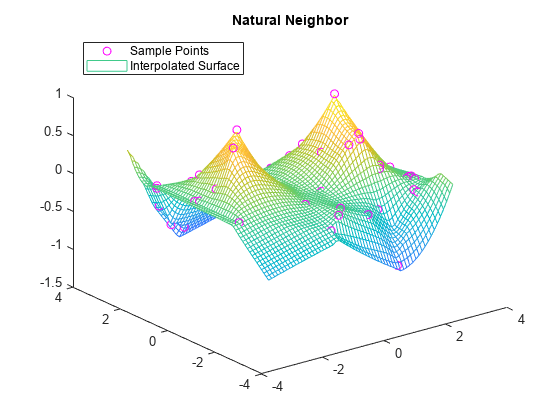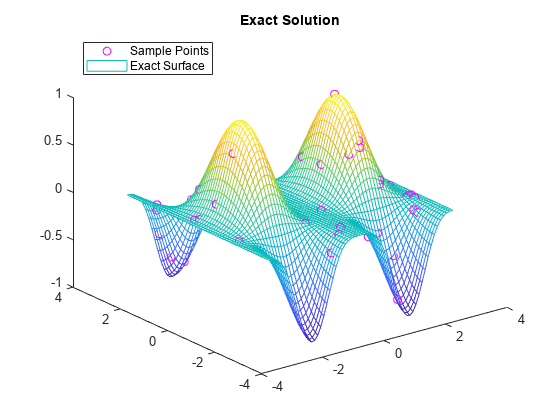scatteredInterpolant
2차원 또는 3차원 산점 데이터 보간
설명
scatteredInterpolant를 사용하여 2차원 또는 3차원 산점 데이터의 데이터 세트에 보간을 수행합니다. scatteredInterpolant는 지정된 데이터 세트에 대해 보간 함수 F를 반환합니다. 2차원에서는 (xq,yq)와 같은 일련의 쿼리 점에서 F를 실행하여 보간된 값 vq = F(xq,yq)를 생성할 수 있습니다.
griddedInterpolant를 사용하여, 그리드 데이터에 대해 보간을 수행합니다.
생성
구문
설명
F = scatteredInterpolant
F = scatteredInterpolant(___,Method)'nearest', 'linear' 또는 'natural'을 지정합니다.
F = scatteredInterpolant(___,Method,ExtrapolationMethod)Method와 ExtrapolationMethod를 전달합니다.
입력 인수
속성
사용
설명
scatteredInterpolant를 사용하여 보간 함수 F를 생성합니다. 그런 다음, 다음 구문 중 하나를 사용하여 특정 점에서 F를 계산할 수 있습니다.
Vq = F(Pq)는 행렬 Pq의 쿼리 점에서 F를 계산합니다. Pq의 각 행은 쿼리 점의 좌표를 포함합니다.
Vq = F(Xq,Yq)와 Vq = F(Xq,Yq,Zq)는 쿼리 점을 크기가 동일한 두 개 또는 세 개의 배열로 지정합니다. F는 쿼리 점을 열 벡터로 취급합니다(예: Xq(:)).
F의Values속성이 샘플 점에서의 값 세트 하나를 나타내는 열 벡터이면Vq는 쿼리 점과 크기가 같습니다.F의Values속성이 샘플 점에서의 여러 값 세트를 나타내는 행렬이면Vq는 행렬이고 각 열은 쿼리 점에서의 서로 다른 값 세트를 나타냅니다.
예제
세부 정보
팁
함수
griddata또는griddatan을 사용하여 보간을 따로따로 계산하는 것보다 여러 쿼리 점에서scatteredInterpolant객체F를 실행하는 편이 더 빠릅니다. 예를 들면 다음과 같습니다.% Fast to create interpolant F and evaluate multiple times F = scatteredInterpolant(X,Y,V) v1 = F(Xq1,Yq1) v2 = F(Xq2,Yq2) % Slower to compute interpolations separately using griddata v1 = griddata(X,Y,V,Xq1,Yq1) v2 = griddata(X,Y,V,Xq2,Yq2)
보간 샘플 값 또는 보간 방법을 변경하려면 새로운
scatteredInterpolant객체를 만드는 것보다 interpolant 객체F의 속성을 업데이트하는 편이 더 효율적입니다.Values또는Method를 업데이트할 경우 입력 데이터의 기본 들로네 삼각분할은 변경되지 않으므로 새 결과를 신속히 계산할 수 있습니다.scatteredInterpolant를 통한 산점 데이터 보간은 데이터의 들로네 삼각분할을 사용하기 때문에, 보간은 샘플 점x,y,z또는P의 스케일링 문제에 민감할 수 있습니다. 스케일링 문제가 발생하는 경우normalize를 사용하여 데이터를 다시 스케일링하고 결과를 개선할 수 있습니다. 자세한 내용은 크기가 서로 다른 데이터를 정규화하기 항목을 참조하십시오.
알고리즘
scatteredInterpolant는 샘플 산점의 들로네 삼각분할을 사용하여 보간을 수행합니다 [1].
참고 문헌
[1] Amidror, Isaac. “Scattered data interpolation methods for electronic imaging systems: a survey.” Journal of Electronic Imaging. Vol. 11, No. 2, April 2002, pp. 157–176.
확장 기능
버전 내역
R2013a에 개발됨참고 항목
griddedInterpolant | griddata | griddatan | ndgrid | meshgrid









